
Have you ever been in the situation where you’re getting plenty of traffic but not getting enough conversions?
In most cases that’s a huge red flag that you need to reevaluate your UX design. Unfortunately, unlike most marketing metrics, you can’t simply look at a design and determine what does and doesn’t work.
Instead, by calculating the ratios of select indicators, you’ll be able to get an idea of your design effectiveness. Below are just a few indicators which can simplify your UX efforts.
Before getting started, remember that for these projects you can’t just gather information blindly. Remember that data is only helpful if it is relevant to the project.
Cart Abandonment

Online checkout design is one of the biggest challenges for web development professionals because it’s the backbone of many online businesses. The Baymard Institute puts the average cart abandonment rate at 68.63% – an amount which translates to nearly $4 trillion a year in lost revenue.
One of the biggest reasons for cart abandonment is the length and complexity of the checkout process. Although it’s tempting to leverage upsells and collect user information during the checkout process, remember that the extra steps can cost you money.
If you absolutely need a lengthy checkout process, you should also consider offering an express checkout where customers can immediately make their purchase. Another option to boost your conversions is to run email campaigns to remind users of their abandoned carts. From there, customers can make a purchase, save the item(s) for later, or remove the items from their cart.
Completion Rate
One of the best ways for UX professionals to measure design effectiveness is by calculating the completion rate. In a nutshell, you can calculate this by taking the total number of tasks completed successfully and dividing it by the total number of tasks. Multiply that by 100 and you’ll have the effectiveness percentage. Although the ideal score is 100%, a more practical goal would be around 75% depending on your resources and objectives.
External Metrics
In order to have a complete understanding of your design effectiveness, you’ll also want to consider non-technical metrics such as inbound calls, online vs offline office visits, and customer support performance.
For example, if you release a new product and support teams are constantly answering questions on basic matters, you should consider whether there’s a simpler way to perform the tasks. You’ll need to work alongside sales, support, and marketing teams to ensure that you’re building the best product that works for everyone involved.
In other cases, maybe you’re having success collecting emails, but you need more calls. You’ll want to examine the placement of your phone numbers and check the effectiveness of the calls to action. Finally, if you’re not getting enough in-store traffic, the messaging on your website might need adjustment.
UX Measurement Industry Standards
System Usability Scale
Although ratios and calculations are important, there are times where you need to consider subjective insights. This is where the system usability scale (SUS) comes into play. It’s a ten item questionnaire which happens to be the industry standard for UX professionals gathering subjective information.
The primary benefits of the system are that they’re easy to administer and scale, can be used on small sample sizes, and are statistically valid. Before you use the SUS on your projects, you should note that the scoring system is complex (scores need to be normalized for best results) and it’s not intended to diagnose problems.
Google HEART Framework

To help make UX design a bit easier, Google also has created their own industry standard, the HEART framework, which is short for:
-
Happiness: Measure of user attitudes (e.g. satisfaction, ease of use).
-
Engagement: Level of user involvement, typically measured by the frequency of an action or the depth of interaction.
-
Adoption: Number of new users when a product or feature comes out.
-
Retention: Rate at which existing users are returning. Also known as “churn,” it’s a percentage of users who start using the service and remain active within a given period of time.
-
Task success: Traditional metrics such as search result success, time to upload a photo, profile creation
These aspects can be mixed and matched based on specific project needs.
Getting started
Don’t worry if you feel overwhelmed by these details. As mentioned earlier, these tips aren’t intended to replace the fundamentals of user experience design. It’s just another tool to help you tackle those tough problems which slip through the cracks.
Even if you don’t use the metrics often, it’s good to have a basic idea so you’re able to work more efficiently with your colleagues.
Of course, none of this is a substitute for traditional user interviews, but the information can help shape your agenda when you hold those meetings.
Frequently Asked Questions on Measuring UX Design Success
What are some key metrics to measure the success of UX design?
There are several key metrics that can be used to measure the success of UX design. These include user satisfaction, task completion rate, error rate, learnability, and efficiency. User satisfaction measures how happy users are with your product, while task completion rate measures how many users can complete a given task. Error rate measures how many errors users make while using your product, and learnability measures how quickly new users can learn to use your product. Efficiency measures how quickly users can complete tasks once they have learned how to use your product.
How can I use user feedback to measure UX design success?
User feedback is a valuable tool for measuring UX design success. This can be gathered through surveys, interviews, and usability testing. Feedback can provide insights into what users like and dislike about your product, and can help identify areas for improvement. It’s important to ask specific questions to get detailed feedback, and to analyze this feedback to identify trends and common issues.
What is the role of usability testing in measuring UX design success?
Usability testing plays a crucial role in measuring UX design success. It involves observing users as they interact with your product, and can provide valuable insights into how easy your product is to use, how intuitive the design is, and where users encounter difficulties or frustrations. By identifying and addressing these issues, you can improve the overall user experience and measure the success of your UX design.
How can I measure the efficiency of my UX design?
Efficiency in UX design can be measured by how quickly and easily users can complete tasks. This can be measured through usability testing, where you observe how long it takes users to complete specific tasks. You can also use analytics tools to track user behavior and identify any areas where users may be struggling or taking longer than expected to complete tasks.
How does user satisfaction contribute to UX design success?
User satisfaction is a key indicator of UX design success. If users are satisfied with your product, they are more likely to continue using it, recommend it to others, and have a positive overall perception of your brand. User satisfaction can be measured through surveys and feedback, and can provide valuable insights into how well your UX design is meeting user needs and expectations.
What is the importance of learnability in UX design success?
Learnability is a crucial aspect of UX design success. It measures how easy it is for new users to learn to use your product. If a product is difficult to learn to use, it can lead to user frustration and abandonment. Learnability can be measured through usability testing, by observing how quickly new users can learn to use your product and complete tasks.
How can error rate be used to measure UX design success?
Error rate is a measure of how many errors users make while using your product. A high error rate can indicate problems with your UX design, such as confusing navigation or unclear instructions. By identifying and addressing these issues, you can reduce the error rate and improve the overall user experience.
How can task completion rate measure UX design success?
Task completion rate measures how many users can successfully complete a given task. This is a key measure of UX design success, as it indicates how effectively your product enables users to achieve their goals. A low task completion rate can indicate problems with your UX design that need to be addressed.
How can I use analytics tools to measure UX design success?
Analytics tools can provide valuable data on user behavior, such as how users navigate your product, where they spend the most time, and where they encounter difficulties or frustrations. This data can be used to identify areas for improvement in your UX design, and to measure the success of your design improvements.
How can I measure the success of my UX design over time?
Measuring UX design success over time involves tracking key metrics, such as user satisfaction, task completion rate, error rate, learnability, and efficiency, over a period of time. This can help you identify trends, see the impact of design changes, and measure the overall success of your UX design.
 Charles Costa
Charles CostaCharles Costa is a content strategist and product marketer based out of Silicon Valley. Feel free to learn more at CharlesCosta.net.




